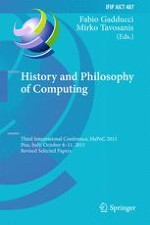
2016 | OriginalPaper | Buchkapitel
Wherefore Art Thou \(\ldots \) Semantics of Computation?
verfasst von : Furio Honsell
Erschienen in: History and Philosophy of Computing
Aktivieren Sie unsere intelligente Suche, um passende Fachinhalte oder Patente zu finden.
Wählen Sie Textabschnitte aus um mit Künstlicher Intelligenz passenden Patente zu finden. powered by
Markieren Sie Textabschnitte, um KI-gestützt weitere passende Inhalte zu finden. powered by